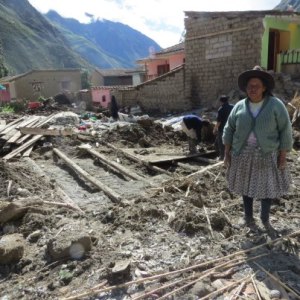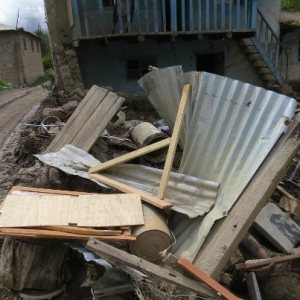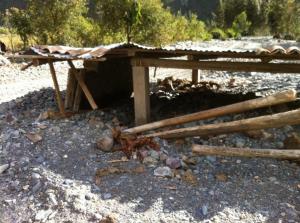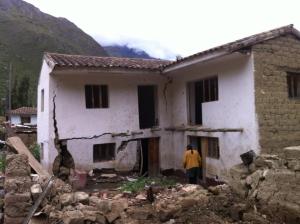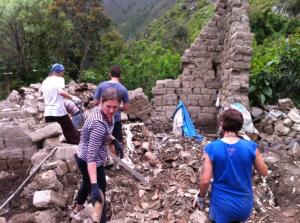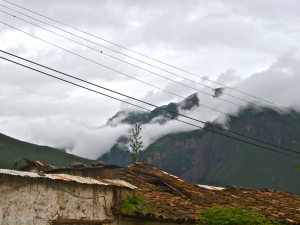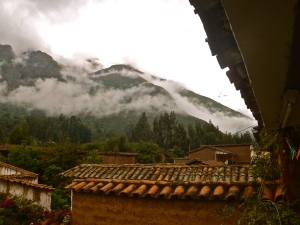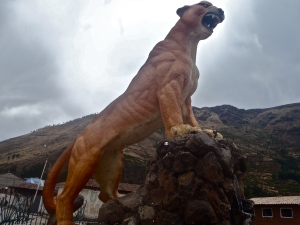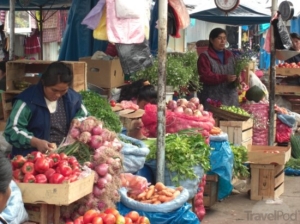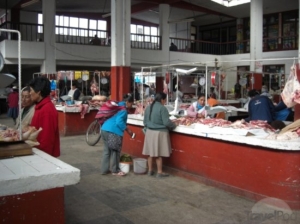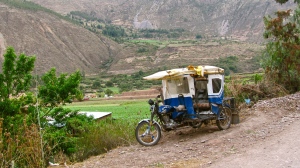Ch-ch-ch-ch-changes!
April 29, 2013
During the Inca Empire, there were shelters posted along the winding mountain roads where soldiers would stop to rest, eat, and prepare to set out for the next battle. The name given to the shelters was “Tambo,” the Spanish translation of the Quechua term tampu. Tambos were built at a distance of exactly one day’s travel. They were functional, sensible, and “un-home-like” … homes. The Incas knew they would rest there at night, be fed and sheltered, and that the next night would reveal a new one, warm and supportive… and unfamiliar. Tambos possessed the characteristics of a home, but the place itself was never the same.
This concept of Tambo has something in common with the experience I’ve had on this trip. I moved to Calca, Peru seven and a half months ago, and in that time I’ve changed homes a total of 4 times. The longest stint that I called a place home was 3 months, the shortest 3 weeks. You can guess which “home” I ran away from kicking and screaming. Maybe it wasn’t that dramatic, but in my mind at the time it probably was.
While this was my third time visiting Peru in the last 3 years, this time I thought I would come to call this beautiful place home. There is something here that has called me back over and over again. The mountains are majestic, the energy charged and intense. Now, as the gods laugh, yet again, at my erroneous theory that I had some kind of cohesive and long-term plan, what I’ve found is that this trip has been all about change.
“All great changes are preceded by chaos.” -Deepak Chopra
Change can throw us off if we let it. And maybe for a time we do. Until we realize that perhaps we have some level of agency in where the next step along the road will take us. For who is the one that ultimately takes the step? Regardless of who says what and what we can glean as true and good for ourselves, we are the agents behind our reality. So we might as well get on with it, face the strain, and use that strain to launch ourselves into something new and great.
I’m speaking to the permanent nature of impermanence that affects the human condition, but in particular, I’m speaking to my own current situation. For a solid two 2 weeks I mourned the loss of a project that I had thought was the purpose behind my trip to Peru. It seemed normal. It was my life not only for the months that I lived here, but it was an idea that was cooking in my mind for almost a year before I made the move. But now I’m realizing that it’s not a question of whether it’s a good or bad thing that it ended. It happened, and now it’s provoking a change, which was bound to happen at some point, in some form.
The end of my project was not the only evidence of change that I’ve experience on this trip. I’ve changed in a big way. I’ve asked myself in the last two weeks: “Why do I keep coming here?” “Why do I repeatedly throw myself into positions where I am far from home, where I know there will be great challenges, and the outcome quite uncertain?” Challenge and struggle can be intensified when one is far from home, far from the support and love of family and friends. The answer to my need to rationalize my recurrent choice to flee home in search of projects and adventure came quickly. I come here to learn and to grow. That’s really it. I’m not sure it matters what it was exactly that I did during my time in South America, although I’ve gained plenty of experience, and picked up a few skills that I value. But the simple act of going there and doing it, yielding to uncertainty and sometimes pain, has provoked change and growth that I intentionally sought out. And I wouldn’t change that.
Dylan said it was the times, but now I know it’s everything, all the time. And taking the advice of a wise man named Kevin Cronin it’s time for me to roll with the changes. And roll on to my next Tambo, my next post from which to set out.
A Poverty of Empowerment: Flooding in Ollantaytambo
March 3, 2013
This isn’t a happy story, but it’s a real one.
I recently attended a “clean up” day at the site of a flood disaster in a town called Tanca, just outside of Ollantaytambo (that’s the town from which hundreds of tourists depart by train for Machu Picchu). Outside of this tourist hub are scattered lots of little communities of campesinos or local farmers – most of whom rely on their corn crops as their only source of income.
In mid-February, the river that runs through these towns flooded and washed out the adobe homes of 75 families. Many lost everything they have, including livestock and their corn crops which will have devastating consequences, as corn is harvested only once per year. Without the immediate donations supplied by generous individuals, including tourists who have given their time and resources to the cause, the people of these towns could face starvation.
Here are some photos of the site:
… And a short video clip of how it happened:
While it was upsetting to see the damage brought about by the flooded river, and the state in which the community members find themselves living now – in leaky, plastic tents provided by the local government – it was even more upsetting to make the realization that there was really nothing that volunteers or donors could do to solve the problem. The most important part of the day was not shoveling debris, or digging rocks out of the water canal. It may have been talking with the people, being a sounding board for their sadness and feelings of defeat. But I suspect it was simply seeing the site. It was important for me personally -although sad and frustrating – to see that the issues run far deeper than lost homes and lost crops. The problems are far more fundamental. They are problems associated with poverty… a lack of the people themselves to feel empowered to go out and utilize their resources. In fact, there is a lack of awareness that they even have any resources. Certainly they have fewer resources than someone like me… I’m fortunate enough to have many resources that, if I were to find myself in a sticky situation – like losing my home and all of my belongings – I would have somewhere to run and people who I could rely on.
What tends to happen is a “poor me” scenario, which, when you look at the place and the situation and the people involved, you might be tempted to agree with them, and endorse such thinking. But when you figure that most of the time spent talking about the situation, including in Assembly meetings, during which all individuals have a turn to speak of their personal predicament, and re-live the events put them in the situation they’re in, you might consider that each passing moment situates them more sturdily in their current dilemma – they are not making any closer movement toward re-building their lives and with a consciousness that will ensure that such events won’t happen again. And it’s not their fault. But they could be empowered.
I thought about the ways I could help. I found myself at a loss. Raising money for the community wouldn’t help – the money would disappear in a day – and no one would be empowered. Going there and shoveling more dirt and moving more house tiles didn’t seem worthwhile. It’s a project in development. And it’s a constant condition in the developing world.
I hope for the best for the communities that were affected by the flooding, and I also worry about the progress. The government has provided tents – a very temporary “solution.” It has also promised (as explained in the video clip) that it would provide the communities with new land on which to build their new homes. So the people comply, waiting for someone, be it volunteers, donors, government, to save them. But, looking at past disasters of similar scale, such as the floods that devastated Taray in 2010, people will wait, and wait, and never see the items promised them. Three years after the floods that killed several people in Taray and washed out 80% of the homes there, families persist in their plastic tents, hoping life will take a turn for the better.
A Day in the Calca Life
February 17, 2013
One of my favorite parts of living in Calca is the morning. I walk out my door and this is what I see:
The clouds nestle into the mountainsides, filling ravines with puffy moisture. The earlier in the day, the heavier the sleepy clouds seem to hang, lifting into the sky as the day matures.
Calca is a hidden treasure in the Valley. Perhaps not everyone would think so, and maybe that’s why it’s so extraordinary. There is something about the small town which sits along the tourist road that runs direct from Cusco to Machu Picchu, where tour busses pass, conscious only of the giant puma statue in front of the gas station. It’s an imposing landmark that might indicate a certain remarkability about the town, but in their rush to reach the Machu Picchu train at Ollantaytambo, tour leaders allow only a moment for photo ops with the fierce feline effigy. No need to venture into Calca… it’s just an ordinary Andean town.
I thought I would take you through a typical day in Calca. Although my day will look quite different from a local campesina or farmer, who might start her day at 4:00a.m., shepherding her llamas, cooking and serving up massive portions of rice, potatoes and turnip greens to her hard-working husband and extended male family members, running up and down paths that cut sharply up the mountains (you should see their calf muscles), and selling weed… I mean weeds for guinea pig and rabbit food on street corners at night.
I, on the other hand, wake up at the tardy hour of 6:00a.m. for a morning run – that is, if I can tolerate the thought of the awaiting glances and giggles from the other early risers wandering the streets. Running in South America does seem to attract plenty of attention.
On the sidewalk I dodge packs of un-fixed dogs of breeds unrecognizable to any dignified, suburban dog-owner in the U.S. I hold my breath and speed up as I unluckily encounter the garbage truck which makes its presence known with literally blaring huayno or traditional Andean music, luring people out of their homes for garbage day. Once out of town I cross the river and run in peace along a seldom used gravel road that borders the roaring Vilcanota a.k.a. Urubamba River.
Later I wander up the hill to the farm with a bucket full of kitchen compost. Along the way I run into a couple of road workers who I know to have had run-ins with our bees. “Hey, you work with bees, don’t you? How many stings have you gotten?” “More than I can count,” I tell them. They proceed to inform me that if one is internally warm… whatever that means… you will swell up more if you are stung, as well as if you drink a lot of alcoholic beverages. I assure them this is not the case, but there is no convincing them… how could I not know this commonly held insight to be total and absolute truth?
I reach the farm and apiary which sits below the compelling Pitusiray mountain. Wanting to drink in the mountain air, I stay for a while at the farm to pull weeds when Yurema, our neighbor wanders in and asks to French braid my hair, which I let her do. When she’s done she squats beside me as I weed around the zucchini plants, observing my technique. I indicate a thriving zucchini that’s almost ready for harvest. Yurema looks serious and abruptly advises me to be more careful not to point at the zucchini plants, as they are sure to die when cursed with such a gesture. “Why?” I ask. “They are shy plants,” she responds without hesitation. She assures me the curse is unforgiving and that should my pointer finger happen to fall in a position in which it’s pointing in the direction of the vegetable, the plant will most certainly die.
Later, after a 5 sol ($2) lunch, I might stop into an internet shop to check my e-mail. Entering the place, I’m immediately nauseated by the smell of stinky, sweaty teenaged boy socks. I talk myself into sitting down at a computer, affirming I will only be there to check a couple of emails. Soon I have two 8 year old boys on ether side of me, competing against each other in some horrible warfare game, screaming in my ears and running back and forth between the wall and where I sit, bumping me every time. They don’t seem to notice my looks of disapproval and annoyance.
Maybe I’ll hit the market for some groceries, where I pass vedor after vendor, “Que deseas, Mamita? Peras, fresas, hay mandarina.” I bee-line past the meat section where I notice a man using a hand saw to remove a leg from an unidentifiable animal carcass. I head for my caseritas, or vendor ladies who I frequent. I have my vegetable lady, who calls 1.3 kilos 1 kilo because I’m her caserita, and am loyal to her veggie stand. Then there’s my fruit caserita who throws an extra orange into my bag. Then I visit the grain girl who has a metal star embedded into her front tooth, who is constantly surrounded by at least 10 other buyers, and who has everything under the sun from coconut shavings to quinoa flour to flax seeds. I’m in granola heaven.
Some might find the simplicity of Peru, and a small town like Calca to be frustrating at times. Internet is faulty – even in Cusco I struggle to find a WiFi hub where I can actually load a page. Taxis honk their horns unnecessarily, which can start to drive you into the solitude of a quiet courtyard, or up into the mountain where roads are too steep and rocky for the tiny, 3 wheeled mototaxis to reach.
There are days when the body is so sensitive to the high altitude, that even sitting down, it struggles to take in sufficient oxygen. And those are just some of the daily challenges that I still find exhausting.
But there’s something magnificent about living here. It’s the way the clouds look in the morning. It’s the mountainsides that seem to breathe in rhythm with the heartbeat of the earth. It’s the family I’ve found here. It’s the humor I can generally find in all of the aforementioned inconveniences. And the stimulating environment for personal, spiritual and emotional growth.
